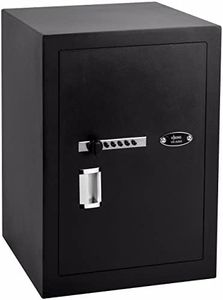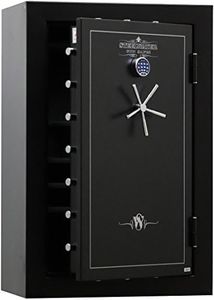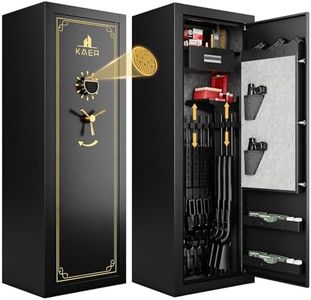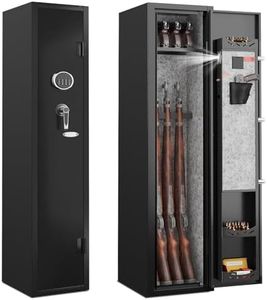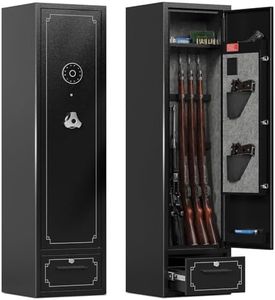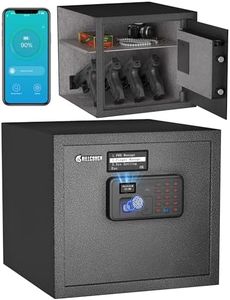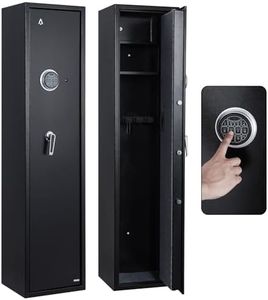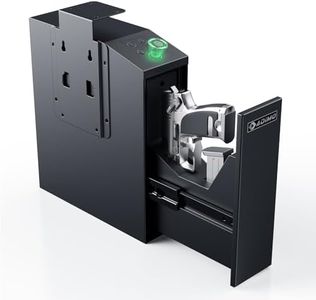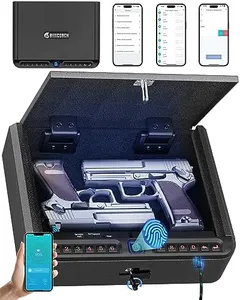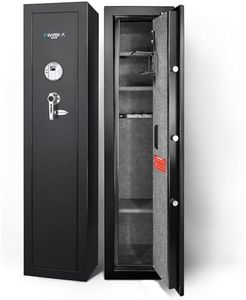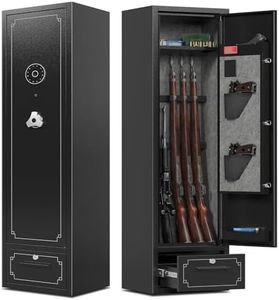10 Best Gun Safes 2025 in the United States
Our technology thoroughly searches through the online shopping world, reviewing hundreds of sites. We then process and analyze this information, updating in real-time to bring you the latest top-rated products. This way, you always get the best and most current options available.

Our Top Picks
Winner
STEELWATER GUN SAFES New Improved Heavy Duty E.M.P Proof, 39 Long Gun, 60 MInute Fire Protection, Auto LED LIghts, Dehumidifier, Door Organizer, Interior Outlet, for Rifles and more. AMLD593924-EMP
Most important from
44 reviews
The Steelwater Gun Safe model AMLD593924-EMP is designed for serious gun owners with a need for high-capacity storage and strong security features. It can hold up to 39 long guns, though realistically fitting 24-30 is more common. The safe stands out with its robust locking mechanism, featuring 20 solid steel locking bolts and an EMP-proof electronic keypad, ensuring strong protection against tampering and EMP attacks. Additionally, the fire protection rating is solid, offering 60 minutes of fire resistance, which is reassuring for keeping valuable firearms safe during a fire emergency. It is built from alloy steel and has a semi-gloss black powder coat finish, both durable and aesthetically pleasing.
The safe weighs a hefty 689 pounds, making it a permanent floor-mounted fixture rather than a portable one. Inside, it comes equipped with automatic LED lighting, a dehumidifier, and a heavy-duty door organizer, all aimed at maintaining and organizing your firearms effectively. Adjustable shelves add flexibility for storing other valuables. However, the weight and bulkiness could be a drawback if you need a more portable or easily relocatable option. Also, while the electronic combination lock is highly secure, it does rely on battery power, which necessitates regular checks and replacements.
This Steelwater model might be best suited for gun enthusiasts with a significant collection and a permanent place to securely store it.
Most important from
44 reviews
STEELWATER GUN SAFES New Improved E.M.P Proof, 20 Long Gun, 60 MInute Fire Protection, Auto LED LIghting, Dehumidifier, and Door Organizer kit, for Rifles, Pistols, and other valuables. AMEGS5928-EMP
Most important from
151 reviews
The Steelwater Gun Safes AMEGS5928-EMP is a high-quality option for storing rifles, pistols, and other valuables. It boasts a maximum capacity of 20 long guns, though the average capacity typically ranges between 12 to 16 guns. The safe is equipped with a robust locking mechanism featuring 10 solid steel bolts, providing security on all four sides. This model includes an EMP-proof keypad and a high-security bypass key, ensuring reliable access even during power outages.
Additionally, the digital keypad adds a layer of convenience and security. The fire protection is impressive, offering 60 minutes of resistance at temperatures up to 1875°F, which is crucial for safeguarding your firearms and valuables in case of a fire. Constructed from alloy steel with a semi-gloss textured powder coat, it combines durability with an attractive finish. The safe is quite heavy, weighing 408 pounds, which could be seen as a drawback for those needing portability. However, this weight contributes to its sturdiness and burglary resistance.
Interior features include automatic LED lighting, a dehumidifier, and a door organizer kit, enhancing convenience and organization. The adjustable shelves offer versatility in storage options. While the weight and size (18”D x 28”W x 59”H) might make it challenging to relocate, its floor mount design ensures stability. The return policy within 30 days, although subject to return fees, provides some peace of mind for buyers. This gun safe is ideal for those seeking robust protection, advanced security features, and comprehensive fire resistance in a fixed location.
Most important from
151 reviews
KAER 25 Gun Safe Biometric - Gun Safe for Rifles and Pistols Assembled, Large Gun Cabinet for Shotguns, Digital Fingerprint Rifle Safe with Removable Gun Racks,Pistol Pockets
Most important from
65 reviews
The KAER 25 Gun Safe Biometric is designed for those who need a large, secure storage solution for rifles and pistols. Its spacious interior can hold up to 25 firearms, including long guns with scopes, thanks to adjustable shelves and soft felt lining that help protect your guns from scratches. The safe comes fully assembled, which is convenient, and offers flexible installation options either on the floor or mounted to a wall.
Security is a strong point here, with a biometric fingerprint scanner that can store up to 30 prints, plus a keypad and emergency keys for multiple access methods. The heavy-duty cold-rolled steel construction, pry-resistant door, solid core bolts, and concealed hinges add good physical protection against theft. It also features an alarm system that triggers after multiple incorrect attempts or if the safe is moved, with a silent mode option for discreet security. Weighing 123 pounds, it is sturdy but still manageable to install with the included hardware.
While the safe offers solid theft protection, it doesn’t mention specific fire resistance ratings, so it may not provide strong fire protection compared to some specialized safes. This model suits gun owners who prioritize biometric access and large capacity in a secure, ready-to-use package, though those requiring high fireproof performance might need to consider other options.
Most important from
65 reviews
Buying Guide for the Best Gun Safes
When it comes to buying a gun safe, it's crucial to ensure that you are making a well-informed decision to protect your firearms and other valuables. A gun safe not only provides security against theft but also ensures that your firearms are safely stored away from unauthorized access, especially children. To choose the best gun safe for your needs, you should consider several key specifications that will help you determine the right fit for your requirements.FAQ
Most Popular Categories Right Now
